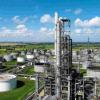Dear,
Could you please explain what is the difference between Density at 15 0C in Air and Density at 15 0C in vacuum for petroleum products.
Is there any mathematical expression to convert one from another.
Regards
|
|
Posted 13 August 2014 - 03:42 PM
Dear,
Could you please explain what is the difference between Density at 15 0C in Air and Density at 15 0C in vacuum for petroleum products.
Is there any mathematical expression to convert one from another.
Regards
Posted 14 August 2014 - 12:18 AM
The difference is the bouyancy force of the air that is displaced. Density is defined as mass/volume, but for practical reasons this is often substituted by weight/volume. The weight is measured by measuring the force with which the substance is attracted to earth by gravity. The net force is affected by the bouyancy (or density) of the surrounding fluid. This results in the weight being less if it is measured in water than if it is measured in air, and similarly it weighs less when measured in air than in vacuum.
It is complicated by the method used to weigh the sample. The best known case that I am aware of is the TTB Tables that are used in the alcoholic beverage industry in the USA. These give weights of a gallon of spirit as a function of the spirit proof in air and in vacuum. These tables date from around 1910 when electronic scales did not exist, so the sample was weighed on a balance scale using brass weights. In the same way that the sample being weighed is subject to air bouyancy, on a balance scale the reference weights are also subject to bouyancy. This makes that sample weigh more than you would expect by subtracting the mass of the displaced air from the mass of the sample because you have to add back in the mass of the air displaced by the reference weights.
Knowing all this you can develop mathematical expressions for the conversions to suit your method of weighing.
Posted 14 August 2014 - 01:43 PM
Dear katmar,
is it correct to use this expression
Density at 15 0C in air = Density at 15 0C in vacuum - 0.0011
I found it on some websites. I mean how much is this expression reliable to use.
Thank you very much for the previous answer
Posted 14 August 2014 - 03:18 PM Best Answer
Depending on how accurate you need to be, that could be a reasonable approximation. I guess you are talking units of kg/litre or g/cm3 - or maybe SG.
If you wanted to measure the density of the fluid by weighing exactly 1 litre of it then you would be displacing 1 litre of air, which has a mass of 0.00123 kg/litre at 15 C and 101.3 kPaa. If the liquid you are working with has a density of about 0.8 then the reference weights used on the scale would have a volume of about 0.1 litre, so the volume of air "displaced" is reduced to 0.9 litres and so the mass displaced is 0.9 x 0.00123 = 0.001107, so I suppose that is where the number comes from.
Strictly, the factor (i.e. 0.0011) should vary with the density of the liquid because that determines the volume of weights used. As I said, it depends on how accurate you want to be.
Posted 15 August 2014 - 09:22 AM
This article has a discussion of buoyancy corrections: https://web.archive....dbook/sop21.pdf
Posted 19 August 2014 - 06:15 AM
This is a very good question as this is commonly encountered when bunkering marine fuel oils. As ever there is always a great deal of confusion surrounding it.
Most often the density of fuel oil is measured using a hydrometer.
However, there is a trend to using coriolis mass meters which report the density calculated from the resonant frequency, a method commonly used with vibrating element density meters and some digital viscometers which also use resonant frequency.
Getting the manufacturers of these instruments to define how they report density is interesting.
There is also confusion within the industry as to whether they are determining the amount bunkered by weight or mass...... and then they often go and round up the density measured by hydrometer to the nearest 0/5kg/m3 to make use of the tables quicker and easier even though calculation is now the approved method rather than the tables. (it also means they often don't apply the individual hydrometer calibration correction either).
Then again some PC programs used in the industry replicate the look up method complete with the 0.5kg/m3 rounding and some do not.
Thanks Mr Shorty for the link.
Understanding Polytropic Head And Its Relationship With Gas DensityStarted by Guest_Kakka_* , 18 Dec 2024 |
|

|
||
What Are The Differences Between Ph,orp & Chlorine Dioxide AnalyseStarted by Guest_Radha Krishnan Siva Kumar_* , 01 Apr 2024 |
|

|
||
Differences Between Demineralized Water And Boiler Feed WaterStarted by Guest_Vegeta_* , 09 Aug 2022 |
|

|
||
Finding The Density Of A CatalystStarted by Guest_Rachel Tee_* , 23 Feb 2021 |
|

|
||
Density Delta Between Water And OilStarted by Guest_CHEMSTRONG_* , 10 Mar 2022 |
|

|